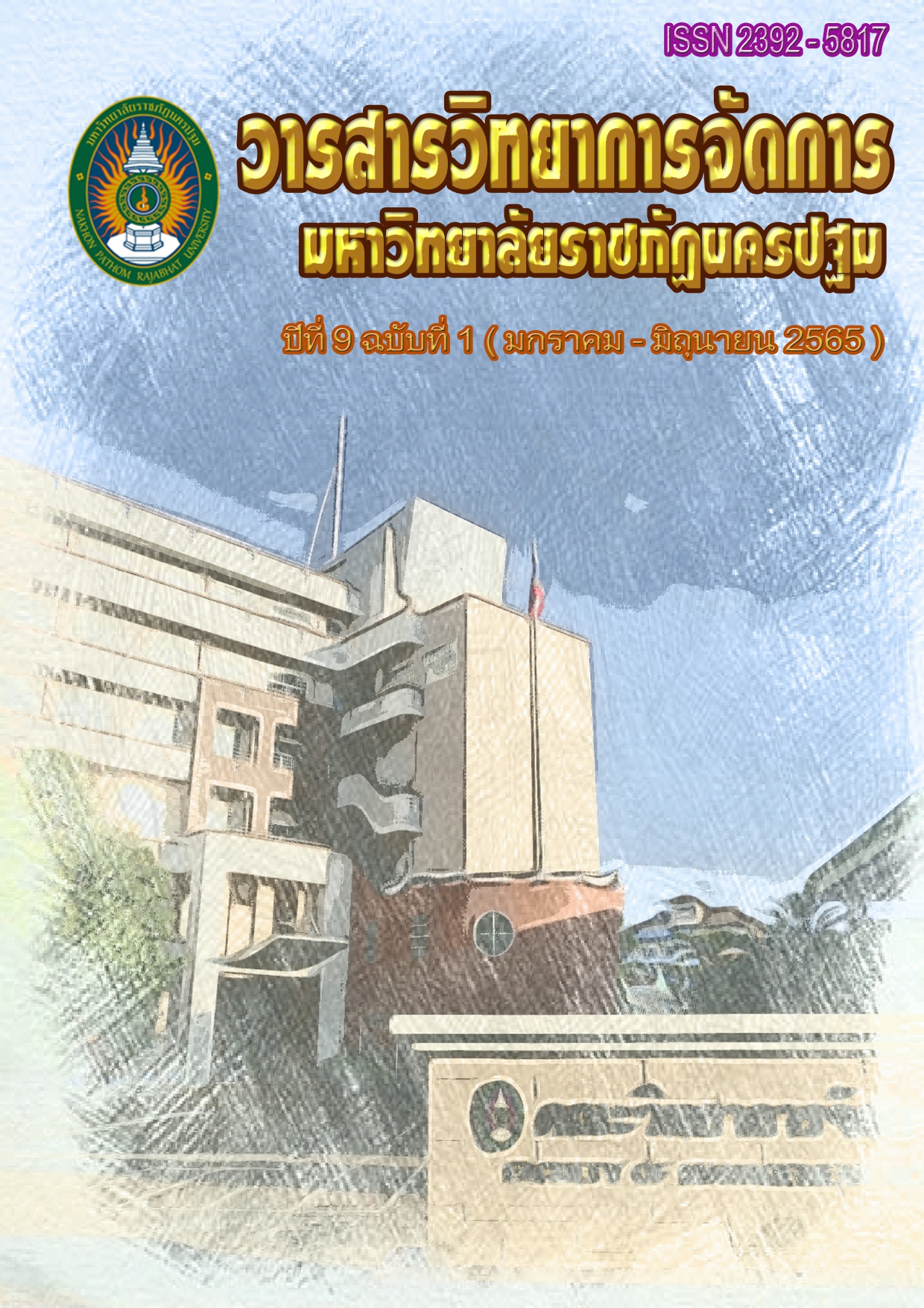A study of supplier relationship management efficiency for Big bike industry at Amata City Rayong
Main Article Content
Abstract
This research is a quantitative research. (Quantitative Research) by using survey research (Survey Research Method) with the objective To study relationship management with trading partners On the results of operations, a case study of the entrepreneurs of the Big bike motorcycle business in Amata City Industrial Estate, Rayong Province, the sample group in this study is 50 entrepreneurs of Big bike motorcycle business in Amata City Industrial Estate, Rayong Province. By using Purposive Sampling, 5 questionnaires were sent to each supplier of inputs for a total of 250 sets. The hypothesis was tested using statistics. Multiple Regression Analysis
The results of the study showed that Managing relationships with trading partners that affect performance The internal processes of Big bike motorcycle entrepreneurs were demand response factor (Beta = 0.323), communication factor (Beta = 0.245) and cooperation factor (Beta = 0.199) at a statistically significant level of 0.05. It was found that the management of relationships with trading partners affected the performance. The customer side was the communication factor (Beta = 0.270), the demand response factor (Beta = 0.211) and the cooperation factor (Beta = 0.179) at the statistical significance level 0.05. Relationships with trading partners affect results of operations the financial aspects of the Big bike motorcycle entrepreneurs were communication factor (Beta = 0.257), cooperation factor (Beta = 0.208) and demand response factor (Beta = 0.182) at the statistical significance level 0.05. Relationships with trading partners affect results of operations the learning and development factors of Big bike motorcycle entrepreneurs were communication factor (Beta = 0.331) and demand response factor (Beta = 0.220) at a statistically significant level of 0.05.
Article history : Received 20 January 2021
Revised 9 May 2021
Accepted 11 May 2021
SIMILARITY INDEX = 6.84 %
Article Details

This work is licensed under a Creative Commons Attribution-NonCommercial-NoDerivatives 4.0 International License.
The views and opinions of the article appearing in this journal are those of the author. It is not considered a view and responsibility of the editorial staff.
References
กิรณา แก้วสุ่น และไกรชิต สุตะเมือง. (2559). อิทธิพลของการจัดการความสัมพันธ์กับผู้จัดหาวัตถุดิบที่มีต่อผลการดำเนินการด้านการจัดซื้อจัดหาผักและผลไม้สดในร้านค้าปลีกสมัยใหม่ในประเทศไทย. วารสารวิชาการ RMUTT Global Business and Economics Review, 11(2), 11-22.
ชนิดา พงษ์พานารัตน์. (2554). การพัฒนาและทดสอบความตรงของตัวชี้วัดกระบวนการบริหารโซ่อุปทานในอุตสาหกรรมบริการ. วิทยานิพนธ์ปริญญาบริหารธุรกิจมหาบัณฑิต มหาวิทยาลัยธรรมศาสตร์.
ธีรวุฒิ เอกะกุล. (2543). ระเบียบวิธีวิจัยทางพฤติกรรมศาสตร์และสังคมศาสตร์. อุบลราชธานี: สถาบันราชภัฎอุบลราชธานี.
นพปฎล สุวรรณทรัพย์ และมณฑลี ศาสนนันทน์. (2557). การเพิ่มประสิทธิภาพทางการจัดซื้อด้วยการจัดการความสัมพันธ์กับผู้จําหน่าย กรณีศึกษา อุตสาหกรรมซ่อมบํารุงอากาศยานในประเทศไทย. วารสารวิศวกรรมศาสตร์มหาวิทยาลัยศรีนครินทรวิโรฒ, 9(1), 1-15.
บุณฑรี จันทร์กลับ และชลินธร ธานีรัตน์. (2558). การวิเคราะห์โซ่อุปทานของดอกมะลิ กรณีศึกษา ตำบลท่าเรือ อำเภอเมือง จังหวัดนครศรีธรรมราช. วารสารการวิจัยเพื่อพัฒนาชุมชน (มนุษยศาสตร์และสังคมศาสตร์), 8(1), 91-107.
ศรายุทธ ตรัยศิลานันท์. (2554). ความสัมพันธ์ห่วงโซ่อุปทานระหว่างผู้จัดหาวัตถุดิบกับผู้ซื้อในอุตสาหกรรมอาหารจังหวัดนครราชสีมา. วิทยานิพนธ์ปริญญาการจัดการมหาบัณฑิต สาขาวิชาเทคโนโลยีการจัดการ มหาวิทยาลัยเทคโนโลยีสุรนารี.
สุรสา บุญทา. (2554). การประเมินประสิทธิภาพสายโซ่อุปทานอุตสาหกรรมชิ้นส่วนยานยนต์ในประเทศไทย. วิทยานิพนธ์ปริญญาวิทยาศาสตรมหาบัณฑิต สาขาวิชาการจัดการด้านโลจิสติกส์ (สหสาขาวิชา) จุฬาลงกรณ์มหาวิทยาลัย.
Anderson, J. Narus, J. (1990). A model of distributor firm and manufacturer firm working Partnerships. Journal of Marketing, 54(1), 42-58.
Cambra, J., Polo, Y. (2007). Assessment and reassessment of supply relationships: a case study in the Spanish wine industry. International Journal of Entrepreneurial Behaviour and Research, 13(2), 82-106.
Cannon, J., Homburg, C. (2001). Buyer-supplier relationships and customer firm costs. Journal of Marketing, 65(1), 29-43.
Cannon, J., Perrault, W. (1999). Buyer - seller relationships in business markets. Journal of Marketing Research, 36(4), 439-460.
Fierro, J.C., Redondo, Y.P. (2008). Creating satisfaction in the demand-supply chain: the buyers perspective. Supply Chain Management: An International Journal, 13(3), 211 – 224.
Ganesan, S. (1994). Determinants of long-term orientation in buyer-seller relationships. Journal of Marketing, 58(2), 1-18.
Heffernan, T. (2004). Trust formation in cross-cultural business-to-business relationships. Qualitative Market Research: An International Journal, 7(2), 114 – 125.
Kaplan, R. S. and D. P. Norton. 1996. Using the Balanced Scorecard as a Strategy Management System. Harvard Business Review, 74 (1): 75–85.
Lambert, D.M. Garcia-Dastugue, S.J., & Croxton, K.L. (2005). An Evaluation of Process Oriented Supply Chain Management Frameworks, Journal of Business Logistics, 26(1), 25-51.
Mohr, J., Fischer, R., Nevin, J. (1996). Collaborative Communication in Interfirm Relationships: Moderating Effects of Integration and Control. Journal of Marketing, 60(3), 103-115.
Parsons, A. (2002). What determines buyer-seller relation ship quality. An investigation from the buyer's perspective. The Journal of Supply Chain Management, 38(2), 4-12.
Petersen, K., Handfield, R., Ragatz, G. (2005). Supplier integration into new product development: Coordinating product, process, and supply chain design. Journal of Operations Management, 23(3), 371 – 388.
Rao, S.V.R. ; Raju, M.V.L.N. ; Panda, A.K. ; Reddy, M.R., 2006. Sunflower seed meal as a substitute for soybean meal in commercial broiler chicken diets. Br. Poult. Sci., 47 (5): 592-598
Siguaw, J., Simpson, P., Baker, T. (1998). Effects of supplier market orientation on distributor market orientation and the channel relationship: the distributor perspective. Journal of Marketing, 62(3), 99-111.


